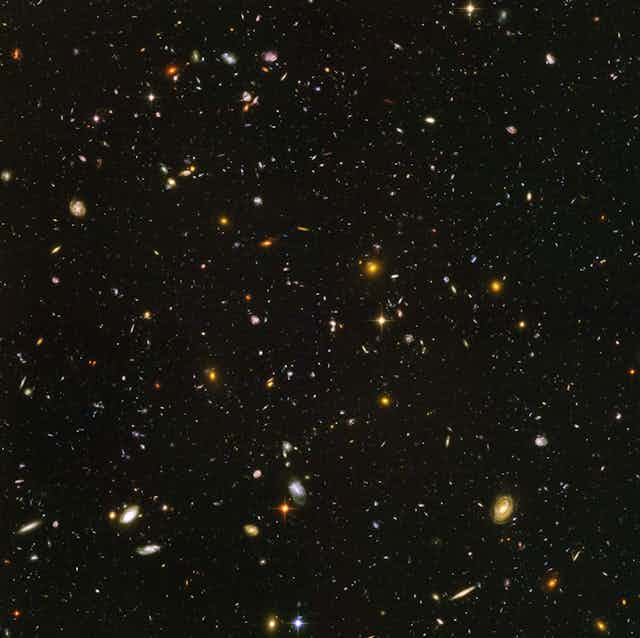There are so many galaxies in the universe that if you point a telescope in any direction in the night’s sky you are bound to see some.
Just look at the image (above) of the sky as provided by the Hubble telescope.
It shows so many galaxies of different sizes and shapes, but which ones are really larger? And which ones are simply closer to us therefore appearing as if they were bigger than the others?
We cannot tell with full certainty simply by looking at the image. In order to distinguish more about the size of a galaxy we need to know its distance from us.
How far is far, far away?
Astronomers have their ways to measure a distance to a galaxy which allows them to solve this conundrum. One of the most popular methods, and in most cases, the only method that can be used to measure a distance to a remote galaxy, is to analyse its electromagnetic spectrum which includes the visible light that enables us to see it.
Since the universe is expanding, all distant galaxies are moving away from us. Because of this motion the spectrum of a galaxy is shifting towards its red part – the redshift as it is known to astronomers.
The redshift phenomenon is a manifestation of the Doppler effect - the faster the motion, the larger the shift of the frequency. Therefore, the larger the redshift, the greater the distance to the observed galaxy.
The exact relation between the redshift and distance follows from the cosmological model of the universe. So if astronomers can measure a distance in some other way, then by comparing the observed distance and redshift with a prediction, they can measure the properties of our universe such as for example the amount of dark matter and dark energy.
There is, however, one problem here.
The swarm of galaxies
If a galaxy is moving on the top of the global expansion of the universe, then this motion, via the Doppler effect, contributes to the observed redshift. And galaxies move all the time, just as molecules of the air, or bees within a swarm.
The contribution from this local motion is not big if compared to a motion that follows from the expansion of the universe. Still this additional redshift introduces noise to our measurements. This noise then distorts our estimation of the distance, and therefore our estimation of the real size of the observed galaxy.
Doppler lensing
This is what is called the Doppler lensing - “Doppler” because of the Doppler effect involved, and “lensing” because this effect distorts the inferred size, just as the observed size of an object is distorted when observed through an optical lens.
How then can we tell what is the real size of a galaxy? If all galaxies are moving and if their motion distorts our measurements then that sounds like a real mess.
However, this “mess” or to be precise the amount of “messiness” can give us a very good insight into what our universe is made of. Astronomers are now in a situation similar to radar operators who during World War II complained about “noise” in returned echoes due to rain, snow, and sleet. Back then it was a nuisance, now we actually look for this “noise” in order to predict weather.
Similarly, if astronomers could measure apparent sizes of a very large number of galaxies, and correlations between them, then they could estimate an average amplitude of the “noise”. Using the technique based on the Doppler lensing effect, they can measure properties of our universe and estimate how much dark matter and dark energy it contains.
Deciphering the noise
With large galaxy surveys such as Dark Energy Survey (DES) and the contribution from the Australian OzDES we will be able to measure this effect.
Further, much larger surveys will follow after completion of the Square Kilometre Array telescope, currently being built partly in Western Australia and partly in South Africa, and utilise the Doppler lensing effect to get a better insight into properties and mysteries of our universe.

The calculations and the method itself were recently developed by a group of astronomers from Australia, South Africa, and United Kingdom.
The method shows how by measuring correlations in the distortion of sizes of galaxies we can learn about the properties of our Universe (such as amount of dark matter and dark energy).
This method and predictions that follow from this method will be presented today at the 8th Workshop of the Australian National Institute for Theoretical Astrophysics (ANITA) hosted by the Sydney Institute for Astronomy (SIfA) at the University of Sydney.

